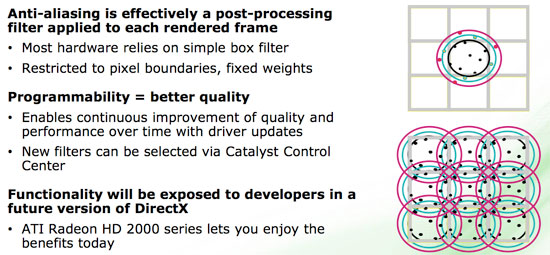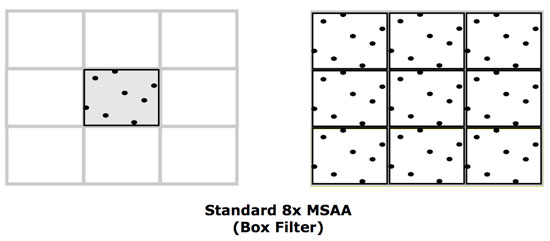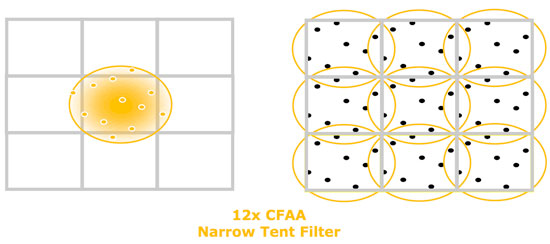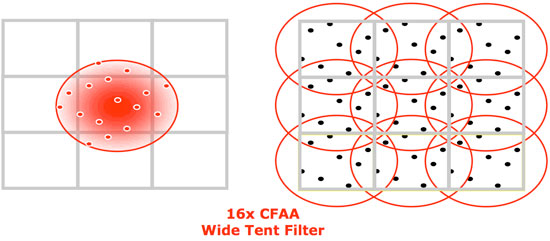ATI Radeon HD 2900 XT: Calling a Spade a Spade
by Derek Wilson on May 14, 2007 12:04 PM EST- Posted in
- GPUs
CFAA and No Fixed Resolve Hardware
That's right, R600 doesn't have hardware dedicated to resolving MSAA in the render back end - the only MSAA related tasks handled in the render back end are compression and evaluation of the subpixels. All antialiasing resolve is performed on the shader hardware. Certainly, AMD would prefer we start by telling you about the neat custom resolve filters that can be implemented on their shader hardware, but we would rather speculate about this for a moment first.
AMD has stated that, moving forward, in addition to allowing programmable sample patterns, future DX versions may allow for custom resolve filters as well. This is cited as one of the reasons why R600 uses shader hardware to resolve AA samples. AMD has given us a couple different resolve filters to play with, which we'll talk about in a minute. But at a point where we're seeing the first DX10 hardware from graphics makers, and at a time where competitive performance is paramount, it doesn't seem like the decision we would have made.
Whatever the circumstances, R600 sends its pixels back up from the render back ends to the shader hardware to combine subpixel data into a final pixel color. In addition to the traditional "box" filter (which uses subpixels within the area of a single pixel), the new driver offers the ability to use subpixel data from neighboring pixels resolved with a tent filter (where the impact of the subpixels on final color is weighted by distance). AMD calls this CFAA for custom filter antialiasing.

AMD currently offers narrow and wide tent filters which can be implemented using 2, 4, or 8 multisamples per pixel boundary. This gives us nine different AA options including traditional box filters. More filter options can be provided via driver updates, as these are essentially driver managed shader programs. Here's the breakdown of the options based on the type of filter and the number of samples used to resolve each pixel.



One of the useful side effects of these tent filters is that they are also capable of antialiasing interior pixels, not just those covered by more than one triangle. This is helpful in getting rid of aliasing in textures which can occur in certain cases.
While tent filters are a very interesting idea to improve antialiasing, they are not without their drawbacks. First, it is possible for tent filters, even though neighboring subpixel data is weighted less than internal subpixels, to create a muddy look, especially with high contrast fine detail like thin text for example. While tent filters can antialias textures on interior pixels, they can also create a blur effect where it isn't needed which removes detail from the scene.
Edge Detection
While tent filters are good in the general edge case, in order to be really compelling from an image quality stand point, AMD decided to go a step further and adaptively apply more AA in places where it would do the most good and less elsewhere. This will be done by applying an edge detect algorithm to the framebuffer and using more aggressive AA on these edges.
We learned that edge detection can be sped up by looking at pixel compression. If all the subpixels for one fragment are the same color, compression will be at its highest and there is no edge within that pixel. Beyond using this information, we are told that the algorithm uses straightforward derivative computations to find high frequency data (high contrast edges) much the same way Photoshop does.
The combination of edge detection and tent filters gives us two extra option beyond the ones listed above: 12x narrow tent filter with edge detect and 24x wide tent filter with edge detect. These filters are capable of very good image quality, though this quality does come at a performance cost. We will take a look at performance and image quality after we finish going through R600 hardware.










86 Comments
View All Comments
johnsonx - Monday, May 14, 2007 - link
and to which are you going to admit to?What was that old saying about glass houses and throwing stones? Shouldn't throw them in one? Definitely shouldn't them if you ARE one!
Puddleglum - Monday, May 14, 2007 - link
You mean, while it does compete performance-wise?johnsonx - Monday, May 14, 2007 - link
No, I'm pretty sure they mean DOESN'T. That is, the card can't compete with a GTX, yet still uses more power.INTC - Monday, May 14, 2007 - link
Chadder007 - Monday, May 14, 2007 - link
When will we have the 2600's out in review?? Thats the card im waiting for.TA152H - Monday, May 14, 2007 - link
Derek,I like the fact you weren't mincing your words, except for a little on the last page, but I'll give you a perspective of why it might be a little better than some people will think.
There are some of us, and I am one, that will never buy NVIDIA. I bought one, had nothing but trouble with it, and have been buying ATI for 20 years. ATI has been around for so long, there is brand loyalty, and as long as they come out with something that is competent, we'll consider it against their other products without respect to NVIDIA. I'd rather give up the performance to work with something I'm a lot more comfortable with.
The power though is damning, I agree with you 100% on this. Any idea if these beasts are being made by AMD now, or still whoever ATI contracted out? AMD is typically really poor in their first iteration of a product on a process technology, but tend to improve quite a bit in succeeding ones. I wonder how much they'll push this product initially. It might be they just get it out to have it out, and the next one will be what is really a worthwhile product. That only makes sense, of course, if AMD is now manufacturing this product. I hope they are, they surely don't need to make anymore of their processors that aren't selling well.
One last thing I noticed is the 2400 Pro had no fan! It had a heatsink from Hell, but that will still make this a really attractive product for a growing market segment. Any chance of you guys doing a review on the best fanless cards?
DerekWilson - Wednesday, May 16, 2007 - link
TSMC is manufacturing the R600 GPUs, not AMD.AnnonymousCoward - Tuesday, May 15, 2007 - link
"I bought one, had nothing but trouble with it, and have been buying ATI for 20 years."That made me laugh. If one bad experience was all it took to stop you from using a computer component, you'd be left with a PS/2 keyboard at best.
"...to work with something I'm a lot more comfortable with."
Are you more comfortable having 4:3 resolutions stretched on a widescreen? Maybe you're also more comfortable with having crappier performance than nvidia has offered for the last 6 months and counting? This kind of brand loyalty is silly.
MadBoris - Monday, May 14, 2007 - link
As far as your brand loyalty, ATI doesn't exist anymore. Furthermore AMD executives will got the staff so you can't call it the same.Secondly, Nvidia has been a stellar company providing stellar products. Everyone has some ups and downs. Unfortunately with the hardware and drivers this is ATI's (er AMD's) downs.
This card should do ok in comparison to the GTS, especially as drivers mature. Some reviews show it doing better than GTS640 in most tests, so I am not sure where or how discrepencies are coming about. Maybe hardware compatibility, maybe settings.
rADo2 - Monday, May 14, 2007 - link
Many NVIDIA 8600GT/GTS cards do not have a fan, are available on the market now, and are (probably; different league) much more powerful than 2400 ;) But as you are a fanboy, you are not interested, right?